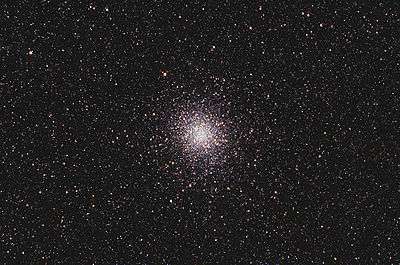| Messier 22 | |
|---|---|
 Core of Messier 22 | |
| Observation data (w:J2000 epoch) | |
| Class | VII |
| Constellation | Sagittarius |
| Right ascension | 18h 36m 24.21s[1] |
| Declination | -23° 54′ 12.2″[1] |
| Distance | 10.6 ± 1.0 kly (3.3 ± 0.3 kpc[2]) |
| Apparent magnitude (V) | +6.17[1] |
| Apparent dimensions (V) | 32′.0 |
| Physical characteristics | |
| Mass | kg (105 to 106 M) |
| Radius | 50 ± 5 ly[3] |
| VHB | 14.2 |
| Estimated age | 12 Gyr[4] |
| Notable features | One of four globulars known to contain a planetary nebula. |
| Other designations | NGC 6656, GCl 99[1] |
Messier 22 (also known as M22 or NGC 6656) is an elliptical w:globular cluster in the w:constellation Sagittarius near the w:Galactic bulge region. It is one of the brightest globulars that is visible in the night sky.

History
M22 was one of the first globulars to be discovered in w:1665 by w:Abraham Ihle[2] and it was included in Charles Messier's catalog of w:comet-like objects on June 5, w:1764.
It was one of the first globular clusters to be carefully studied first by w:Harlow Shapley in w:1930. He discovered roughly 70,000 stars and found it had a dense core. [5] Then w:Halton Arp and w:William G. Melbourne continued studies in w:1959.[6] Because of the large color spread of its w:red giant branch (RGB) sequence, which is similar to that observed in w:Omega Centauri, it became the object of intense scrutiny starting in w:1977 with w:James E. Hesser et al.[7][2]
Characteristics
M22 is one of the nearer globular clusters to w:Earth at a distance of about 10,600 w:light-years away. It spans 32' on the sky which translates to a spatial diameter of 99 ± 9 light-years. 32 w:variable stars have been recorded in M22. It is projected in front of the galactic bulge and is therefore useful for its w:microlensing effect on the background stars in the bulge.[4]
Despite its relative proximity to us, this w:metal-poor cluster's light is limited by w:dust extinction, giving it an apparent magnitude of 5.5 making it the brightest globular cluster in the norther hemisphere.[8]
Planetary Nebula
M22 is very unusual in that it is one of only four globulars (the others being M15, w:NGC 6441 and w:Palomar 6) that are known to contain a w:planetary nebula (PN). It was discovered using the w:IRAS satellite by w:Fred Gillett et al.,in 1986 as a pointlike source (w:IRAS 18333-2357)[9] and subsequently identified as a PN in 1989 by Gillett et al.[10] The PN's central star is a blue star. The PN (designated w:GJJC1) is estimated to be a mere ~6,000 years old.[2]
External links
References
- 1 2 3 4 "SIMBAD Astronomical Database". Results for NGC 6656. http://simbad.u-strasbg.fr/Simbad. Retrieved 2006-11-15.
- 1 2 3 4 Monaco, L.; Pancino, E.; Ferraro, F. R.; Bellazzini, M. (2004). "Wide-field photometry of the Galactic globular cluster M22". Monthly Notices of the Royal Astronomical Society 349 (4): 1278–1290. doi:10.1111/j.1365-2966.2004.07599.x. http://adsabs.harvard.edu/cgi-bin/nph-bib_query?bibcode=2004MNRAS.349.1278M.
- ↑ distance × sin( diameter_angle / 2 ) = 50 ly. radius
- 1 2 Gaudi, B. Scott (2002). "Interpreting the M22 Spike Events". The Astrophysical Journal 566 (1): 452–462. doi:10.1086/338041. http://adsabs.harvard.edu/cgi-bin/nph-bib_query?bibcode=2002ApJ...566..452G.
- ↑ Shapley, Harlow (1930). "The Mass-Spectrum Relation for Giant Stars in the Globular Cluster Messier 22". Harvard College Observatory Bulletin 874: 4–9. http://adsabs.harvard.edu/cgi-bin/nph-bib_query?bibcode=1930BHarO.874....4S.
- ↑ Arp, H. C.; Melbourne, W. G. (1959). "Color-magnitude diagram for the globular cluster M22". The Astronomical Journal 64: 28. doi:10.1086/107848. http://adsabs.harvard.edu/cgi-bin/nph-bib_query?bibcode=1959AJ.....64...28A.
- ↑ Hesser, J. E.; Hartwick, F. D. A.; McClure, R. D. (1977). "Cyanogen strengths and ultraviolet excesses of evolved stars in 17 globular clusters from DDO photometry". Astrophys. J., Suppl. Ser. 33: 471. doi:10.1086/190438. http://adsabs.harvard.edu/cgi-bin/nph-bib_query?bibcode=1977ApJS...33..471H.
- ↑ I. Ivans, C. Sneden, G. Wallerstein, R. P. Kraft, J. E. Norris, J. P. Fulbright, and G. Gonzalez (2004). "On the Question of a Metallicity Spread in Globular Cluster M22 (NGC 6656)". Societa Astronomica Italiana 75: 286. http://sait.oat.ts.astro.it/MSAIt750204/PDF/2004MmSAI..75..286I.pdf#search=%22%22NGC%206656%22%20red%20giant%22.
- ↑ Gillett, F. C.; Neugebauer, G.; Emerson, J. P.; Rice, W. L. (w:January 15 w:1986). "IRAS 18333-2357 - an unusual source in M22". Astrophysical Journal, Part 1 (ISSN 0004-637X), w:NASA-supported research. 300: 722–728. doi:10.1086/163846. http://adsabs.harvard.edu/cgi-bin/nph-bib_query?bibcode=1986ApJ...300..722G.
- ↑ Cohen, J. G.; Gillett, F. C. (w:November 15 w:1989). "The peculiar planetary nebula in M22". Astrophysical Journal, Part 1 (ISSN 0004-637X), Research supported by w:California Institute of Technology 346: 803–807. doi:10.1086/168061. http://adsabs.harvard.edu/cgi-bin/nph-bib_query?bibcode=1989ApJ...346..803C.
| |||||